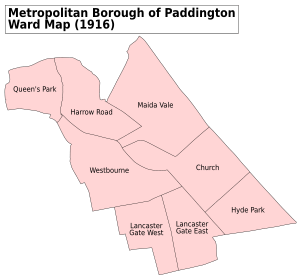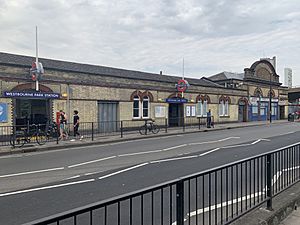Westbourne, London facts for kids
Quick facts for kids Westbourne |
|
|---|---|
 St Stephen's Church, Westbourne Park Road |
|
| London borough | |
| Ceremonial county | Greater London |
| Region | |
| Country | England |
| Sovereign state | United Kingdom |
| Post town | LONDON |
| Postcode district | W2/W11 |
| Dialling code | 020 |
| Police | Metropolitan |
| Fire | London |
| Ambulance | London |
| EU Parliament | London |
| UK Parliament |
|
| London Assembly | |
Westbourne is an area in West London. It has a long history, once being part of a larger area called Paddington. It got its name from the Westbourne River. This river was a small stream that flowed into the River Thames. In the 1850s, the river was covered up and now flows underground.
The name "Westbourne" comes from this stream and the old manor (a large estate) that was here. You can still see the name in places like Westbourne Green, Westbourne Park, Westbourne Gardens, Westbourne Grove, Westbourne Park Road, Westbourne Park tube station, and Westbourne Studios.
Today, Westbourne is part of the Westminster City Council area. It also has a special "Conservation Area." This means the local government protects its unique buildings and history.
Contents
Discovering Westbourne's Early History
The area of Westbourne started as a small village called a "hamlet" in the Middle Ages. It was centered around a place known as Westbourne Green. In those days, it had a big house (a mansion) and a farmhouse.
Records show it was called "Westeburn" in 1222 and "Westborn" in 1294. The green area was known as "Westborne Grene" in 1548. Later, it was called "Washborne Green" in 1680 and "Wesborn Green" in 1754.
How Westbourne Got Its Modern Name
Even after many houses were built, businesses and local groups kept the name "Westbourne" alive.
The southern part of Westbourne green at first was sometimes known as Westbournia. The name, however, also applied to streets south of Westbourne Grove which might have been described more correctly as in Bayswater: Trollope's Westbournia of 1858 was the fashionable neighbourhood of Westbourne Terrace, and c. 1860 Westbourne Grove was recorded as Westbournia's main thoroughfare rather than its boundary. By 1900 Bayswater was thought to end at Westbourne Grove, leaving the district to the north, whose status had fallen, without a general name.
—Paddington: Westbourne T F T Baker, Diane K Bolton and Patricia E C Croot and others, 1989
A London Underground station opened here in 1866 but closed in 1871. A new station opened nearby to the east. Until 1992, this station also had extra platforms for bigger trains. There were many railway yards nearby.
Good transport links and easy access to shops in places like Marylebone encouraged many wealthy people to live in Westbourne. More recently, the Westbourne Park bus garage was built where some of the old railway yards used to be.
Today, the name "Westbourne" is still used in two main ways:
- It is the name of an electoral ward (a voting area) for the Westminster City Council. This ward is north of the Westway road. In 2011, about 12,759 people lived here.
- A smaller area is called the Westbourne Conservation Area. This area was created to protect the beautiful old buildings and their design.
Westbourne's Manor and Parish History
The Westbourne area was once a "manor," which means it was a large estate owned by a lord. It was separate from the Paddington manor. However, Westbourne didn't have its own church. Because of this, it was part of the Paddington parish. This meant people in Westbourne paid taxes (tithes) to Paddington's church and received services from them.
The Westbourne River was the natural border between Westbourne and Paddington. Later, the manor's courts (where legal matters were handled) were held in places like Bayswater and Knightsbridge. This led to the manor being known as "the Manor of Westbourne with Knightsbridge."
Famous Homes and People in Westbourne
In 1746, Westbourne Green had five main houses. The biggest was Westbourne Place, also known as Westbourne House. It was rebuilt in 1745 by architect Isaac Ware as a beautiful Georgian mansion. It had three floors and many windows.
Some famous people who lived there included:
- Sir William Yorke, a diplomat.
- Architect Samuel Pepys Cockerell.
- General Rowland Hill, who was in charge of the British Army from 1828 to 1839.
General Hill left the house in 1836. After he left, the mansion was taken down. Today, the houses of Westbourne Park Villas stand where it used to be. Lord Hill's Bridge, named after him, is still there. It goes over Royal Oak tube station and connects Porchester Road with Harrow Road.
Westbourne Farm was located where the Westway, Harrow Road, and a canal called the Paddington Arm meet. From 1815 to 1817, the famous actress Sarah Siddons and her daughter lived there. Sarah Siddons is buried at St Mary's Church on Paddington Green.
The famous writer Thomas Hardy lived in this area from 1863 to 1867 at 16 Westbourne Park Villas.
Radio presenter and DJ Nihal Arthanayake also used to live in Westbourne Park, near Harrow Road.
Building New Homes: Brunel, Westmead, and Wessex Gardens Estates
By the 1960s, many of the large mansion houses and their grounds were ready for new development. The local government decided to build new housing estates to provide homes for many people.
Two large housing estates were built:
- The Brunel estate, which is about 10 acres, was built in the 1970s.
- The Wessex Gardens estate was built in 1978. It was named after the fictional county in many of Thomas Hardy's books. The first of 300 homes in Wessex Gardens were ready in 1978, planned for over 1,100 people.
Another estate called Westmead was built in 1974. It provided 148 new homes. These new estates helped to improve the housing in the area.




